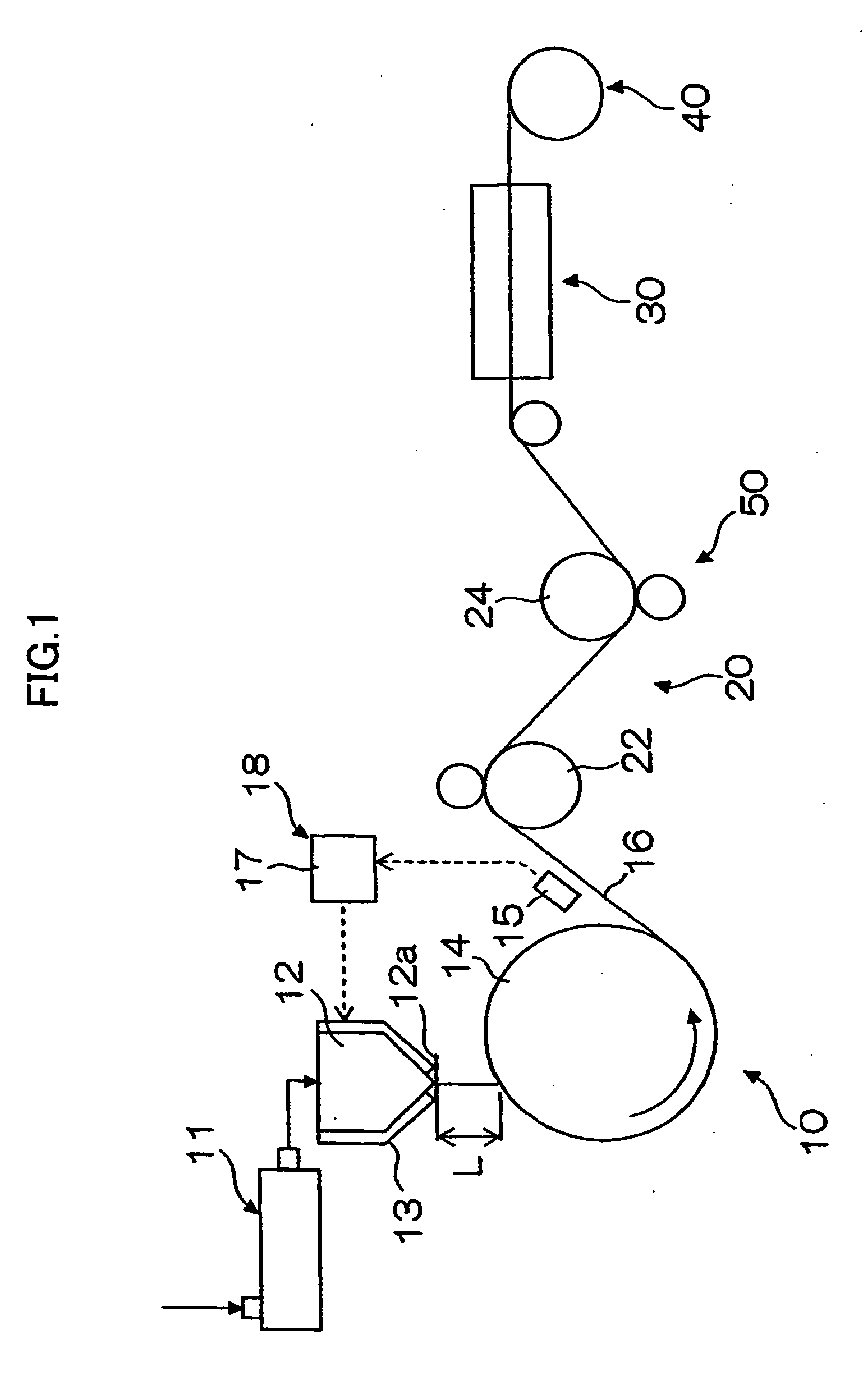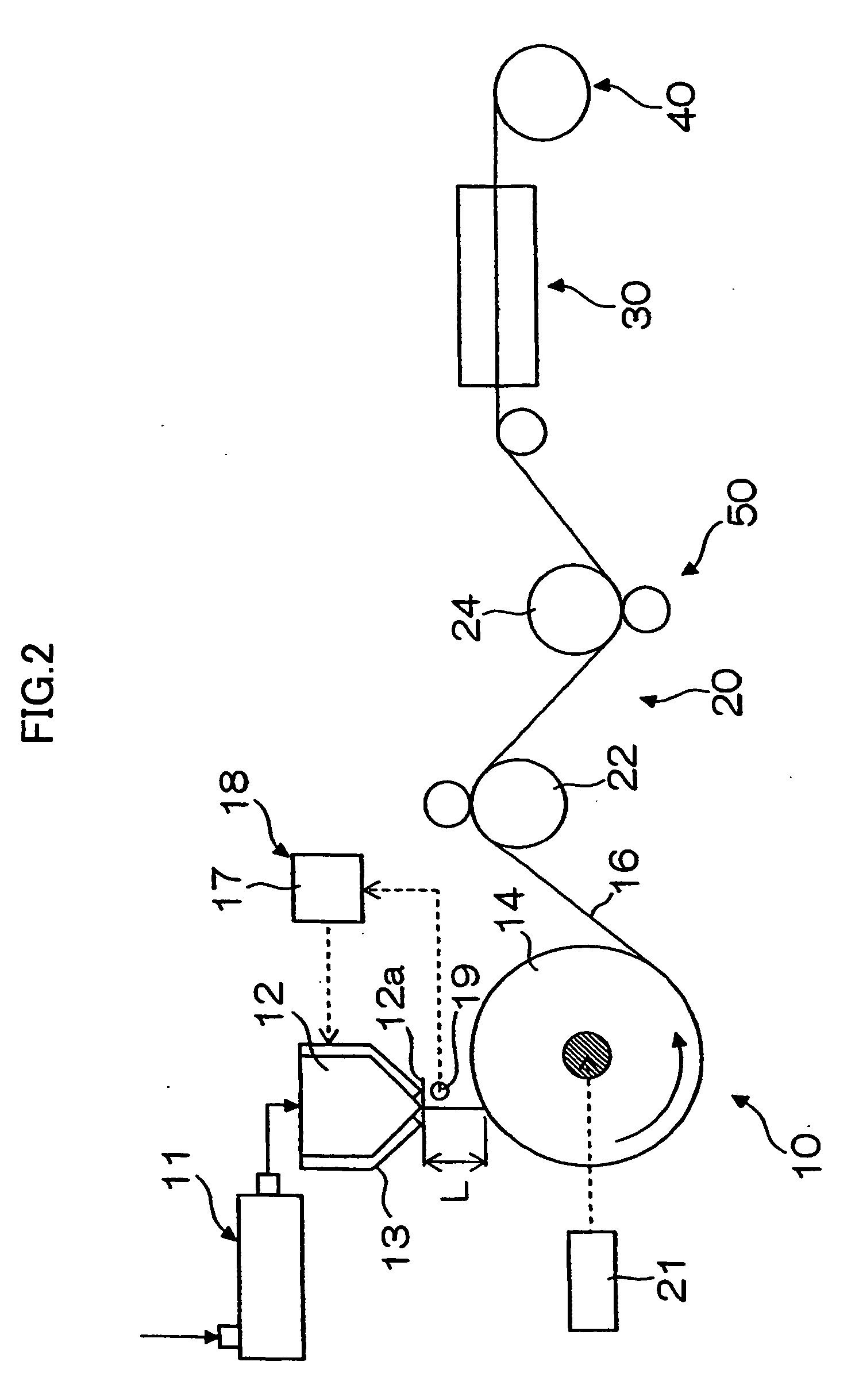Cellulose acylate film, stretched cellulose acylate film, and method and apparatus for producing the same
- Summary
- Abstract
- Description
- Claims
- Application Information
AI Technical Summary
Benefits of technology
Problems solved by technology
Method used
Image
Examples
synthetic example 1
Synthesis of Cellulose Acetate Propionate
[0164] 150 g of cellulose (hardwood pulp) and 75 g of acetic acid were put in a reactor, i.e., a 5 L separable flask equipped with a reflux device. With heating in an oil bath adjusted to 60° C., the mixture was stirred vigorously for 2 hours. By such pre-treatment, the cellulose was swelled and fragmented into fluff pieces. The reactor was put in an ice-water bath at 2° C. for 30 minutes for cooling.
[0165] Separately, a mixture of 1545 g of propionic anhydride and 10.5 g of sulfuric acid was prepared as an acylating agent. After cooling to −30° C., the mixture was added to the reactor containing the above pre-treated cellulose in one portion. After 30 minutes, the external temperature was gradually increased and adjusted so that the internal temperature became 25° C. 2 hours after the addition of the acylating agent. The reactor was cooled in an ice-water bath at 5° C. to adjust the temperature so that the internal temperature was 10° C. 0...
synthetic example 2
Synthesis of Cellulose Acetate Butyrate
[0167] 100 g of cellulose (hardwood pulp) and 135 g of acetic acid were put in a reactor, i.e., a 5 L separable flask equipped with a reflux device. With heating in an oil bath adjusted to 60° C., the mixture was allowed to stand for 1 hour. Then, with heating in an oil bath adjusted to 60° C., the mixture was vigorously stirred for 1 hour. By such pre-treatment, the cellulose was swelled and crushed into fluff pieces. The reactor was put in an ice-water bath at 5° C. for 1 hour to sufficiently cool the cellulose.
[0168] Separately, a mixture of 1080 g of butyric anhydride and 10.0 g of sulfuric acid was prepared as an acylating agent. After cooling to −20° C., the mixture was added to the reactor containing the pre-treated cellulose in one portion. After 30 minutes, the external temperature was increased to 20° C. and the mixture was allowed to react for 5 hours. The reactor was cooled in a ice-water bath at 5° C. and 2400 g of a acetic acid ...
examples
1. Production of Cellulose Acylate Film
(1) Preparation of Cellulose Acylate
[0384] The cellulose acylates listed in Table 4 were charged with sulfuric acid as a catalyst (7.8 parts by weight to 100 parts by weight of cellulose). The resulting solutions were charged with a carboxylic acid, which serves as the raw material for the acyl substituent groups, and an acylation reaction took place at 40° C. At this point, the kind and / or substitution degree of the acyl groups was controlled by the kind and / or amount of the carboxylic acid. After acylation, a ripening was performed at 40° C., whereby samples having different polymerization degrees (the polymerization degree is lowered by lengthening the ripening time) were prepared. The polymerization degree of the thus-obtained cellulose acylates was determined in the following manner.
(Method for Measuring Polymerization Degree)
[0385] About 0.2 g of absolutely dried cellulose acylate was carefully weighed out, and dissolved in 100 ml ...
PUM
| Property | Measurement | Unit |
|---|---|---|
| Temperature | aaaaa | aaaaa |
| Temperature | aaaaa | aaaaa |
| Temperature | aaaaa | aaaaa |
Abstract
Description
Claims
Application Information
 Login to View More
Login to View More - Generate Ideas
- Intellectual Property
- Life Sciences
- Materials
- Tech Scout
- Unparalleled Data Quality
- Higher Quality Content
- 60% Fewer Hallucinations
Browse by: Latest US Patents, China's latest patents, Technical Efficacy Thesaurus, Application Domain, Technology Topic, Popular Technical Reports.
© 2025 PatSnap. All rights reserved.Legal|Privacy policy|Modern Slavery Act Transparency Statement|Sitemap|About US| Contact US: help@patsnap.com



